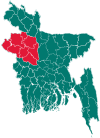Lalpur Upazila
Lalpur
লালপুর | |
|---|---|
Upazila | |
 Lalpur Location in Bangladesh | |
| Coordinates: 24°11′N 88°58.5′E / 24.183°N 88.9750°ECoordinates: 24°11′N 88°58.5′E / 24.183°N 88.9750°E | |
| Country | |
| Division | Rajshahi Division |
| District | Natore District |
| Area | |
| • Total | 327.92 km2 (126.61 sq mi) |
| Population (2011) | |
| • Total | 274,405 |
| • Density | 840/km2 (2,200/sq mi) |
| Time zone | UTC+6 (BST) |
| Website | Official Map of Lalpur |
Lalpur (Bengali: লালপুর) is an upazila of Natore District[1] in the Division of Rajshahi, Bangladesh.
Geography[]
Lalpur is located at 24°11′00″N 88°58′30″E / 24.1833°N 88.9750°E. It has a total area of 327.92 km2. 29 km distance from Natore Sadar. Its Thana Sadar is situated on the bank of river of Padma.
Lalpur Upazila is bounded by Bagha Upazila on west, little part of & Bheramara Upazila on south, Ishwardi Upazila on east, Baraigram Upazila & on north.
Climate[]
It's located in an area which is both the hottest and the coldest in Bangladesh. If temperature comes down to a mild 3 or 3.5 °C at winter, it comes up to 43 °C at summer.
All the year round, temperature remains hottest simultaneously rainfalls are recorded lowest in this part of Bangladesh.
Economy[]
The economy is based on agriculture. Most people are farmers. They produce agriculture crops throughout the year. Paddy, wheat, jute, and sugarcane, are common crops along with potato, pulse fisheries, dairies are the principal crops. North Bengal Sugar Mills in Gopalpur is one of the largest sugar mills in Bangladesh,[citation needed] and produce huge amount of sugar from sugarcane. Farmers also produce huge amounts of date juice in winter and make candy from its remains. Later it is sold to other parts of Bangladesh. Farmers also produce crops for their daily livelihoods. Local varieties of produce include fruits such as mango, jack fruit, banana, guava, black berry, and coconut. After fulfilling their own demand, farmers supply the remainder of their crop to markets all over the country. There are people who live near to Padma; most of time they fish in the river and sell their catches to local fish market to earn money for their living. Many NGOs play a role in national economic growth.[citation needed] These include organizations such as AVA, BRAC, Grameen Bank, SETU, DISHA, UDDIPAN, TMSS and so on.
Demographics[]
| Year | Pop. (000) | ±% |
|---|---|---|
| 1981 | 141 | — |
| 1991 | 230 | +63.1% |
| 2001 | 243 | +5.7% |
| 2011 | 274 | +12.8% |
| Source: Bangladesh Bureau of Statistics[2] | ||
According to the 2011 Bangladesh census, Lalpur Upazila had 66,417 households and a population of 274,405, 7.7% of whom lived in urban areas. 9.4% of the population was under the age of 5. The literacy rate (age 7 and over) was 50.6%, compared to the national average of 51.8%.[3][4]
Administration[]
Lalpur Upazila is divided into Gopalpur Municipality and ten union parishads: Arbab, Arjunpur, Bilmaria, Chongdhupoil, Duaria, Durduria, Iswardi, Kadamchilan, Lalpur, and Oalia. The union parishads are subdivided into 214 mauzas and 217 villages.[2]
Gopalpur Municipality is subdivided into 9 wards and 16 mahallas.[2]
See also[]
- Upazilas of Bangladesh
- Districts of Bangladesh
- Divisions of Bangladesh
References[]
- ^ Md. Moniruzzaman (2012), "Lalpur Upazila", in Sirajul Islam and Ahmed A. Jamal (ed.), Banglapedia: National Encyclopedia of Bangladesh (Second ed.), Asiatic Society of Bangladesh
- ^ Jump up to: a b c "District Statistics 2011: Natore" (PDF). Bangladesh Bureau of Statistics. Archived from the original (PDF) on 13 November 2014. Retrieved 14 July 2014.
- ^ "Community Report: Natore" (PDF). Population & Housing Census 2011. Bangladesh Bureau of Statistics. Retrieved 15 August 2018.
- ^ "Population and Housing Census 2011: Bangladesh at a Glance" (PDF). Bangladesh Bureau of Statistics. Archived from the original (PDF) on 28 July 2014. Retrieved 21 July 2014.
- Upazilas of Natore District
- Rajshahi Division geography stubs

